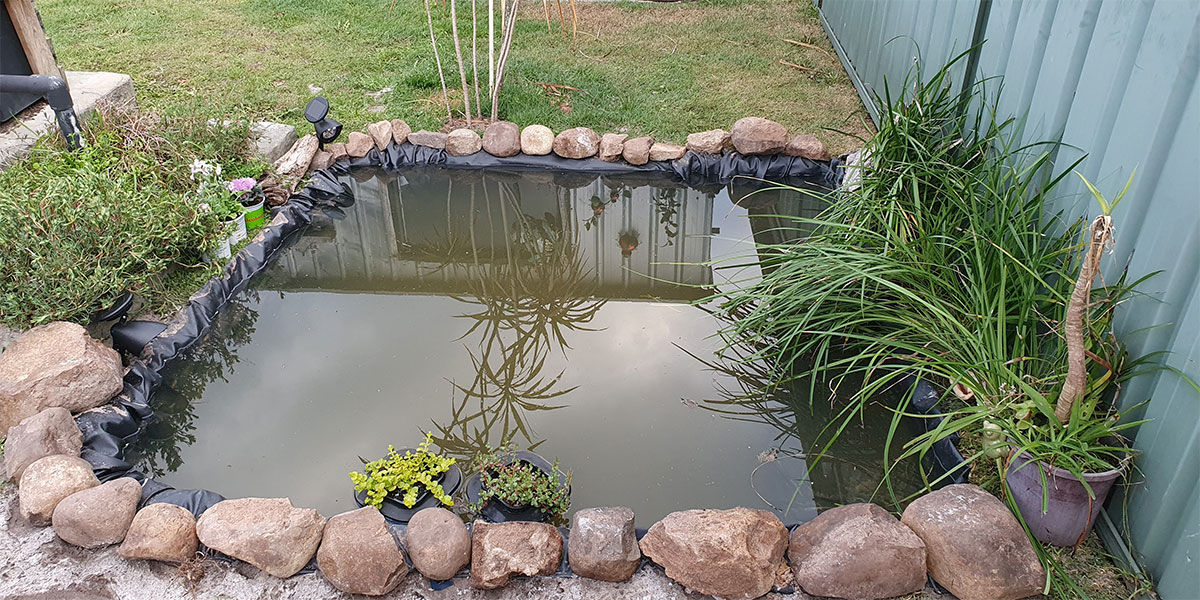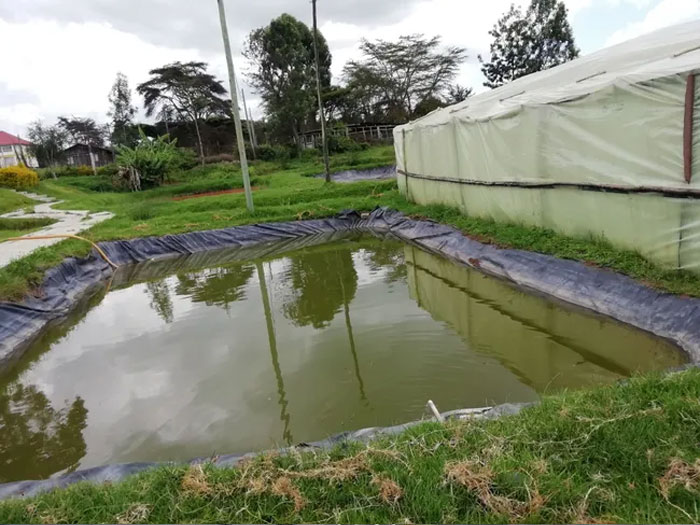
A fish pond is a man-made water body designed to provide a controlled environment for fish farming or recreational purposes. Proper planning and consideration of various factors are essential in building a successful fish pond.
Benefits of having a fish pond
Having a fish farming ponds can provide various benefits, both aesthetic and practical. Here are some advantages of having a fish pond:
- Aesthetic Appeal: A well-designed fish pond can enhance the visual appeal of your property. The sight and sound of water, along with the presence of colorful fish, create a tranquil and relaxing atmosphere. It can serve as a focal point in your garden or outdoor space, adding beauty and charm to the overall landscape.
- Stress Relief and Relaxation: Spending time near a fish pond has a calming effect on the mind and body. Watching the fish swim and listening to the gentle sound of the water can help reduce stress, anxiety, and promote relaxation. It provides a peaceful retreat where you can unwind and enjoy the soothing ambiance.
- Educational and Recreational Opportunities: A fish pond offers educational opportunities, especially for children. It allows them to observe and learn about different fish species, their behaviors, and the ecosystem within the pond. It can also be a recreational activity, where you can feed the fish, interact with them, and even engage in fishing if permitted.
- Environmental Benefits: Fish ponds can contribute to the local ecosystem. They provide a habitat for various aquatic plants and animals, fostering biodiversity. The plants in the pond can help improve water quality by absorbing excess nutrients and reducing algae growth. Additionally, the pond can attract beneficial insects, birds, and other wildlife to your property.
- Water Management and Conservation: Fish ponds can be part of a sustainable water management system. They can collect and store rainwater, reducing runoff and helping to replenish the groundwater table. The water in the pond can be reused for irrigation purposes, reducing the need for additional water sources.
- Personal Food Source: Depending on the type of fish you keep, a fish pond can provide a personal food source. Some pond owners engage in fish farming and harvest fish for consumption. It offers the opportunity to have fresh, homegrown fish without relying on commercial sources.
- Increased Property Value: A well-maintained fish pond can add value to your property. It enhances the overall aesthetics and appeal, making it more attractive to potential buyers. A thoughtfully designed and properly maintained fish pond can be a desirable feature that sets your property apart.
Read more: Geomembranes In Farm Ponds
Different types of fish farming ponds
Here are some common types of fish farming ponds:
- Earthen Ponds: Earthen ponds are the most traditional and widely used type of fish farming ponds. They are excavated or constructed by shaping the soil into a desired pond shape.
- Concrete Ponds: Concrete ponds are constructed using reinforced concrete walls and floors. They are durable, long-lasting, and provide a stable environment for fish farming.
- Plastic-Lined Ponds: Plastic-lined ponds are constructed by lining the pond basin with high-density polyethylene (HDPE) or other suitable liners.
- Cage Ponds: Cage ponds are floating or submerged net enclosures that hold fish within a larger body of water, such as a lake, reservoir, or coastal area. The cages provide containment for the fish while allowing natural water exchange and circulation.
- Raceways: Raceways are long, narrow channels or troughs used for fish farming. They are typically made of concrete or lined with materials like HDPE.
- Recirculating Aquaculture Systems (RAS): RAS are closed-loop systems that recirculate and treat water within a controlled environment. They often consist of tanks or containers where fish are cultured, along with a series of filters and water treatment components.
How to build a fish pond?
Building a fish pond requires careful planning, site preparation, and construction. Here is a general step-by-step guide on how to build a fish pond:
- Planning:
- Determine the purpose of your fish pond, such as recreational fishing, aquaculture, or aesthetic appeal.
- Research local regulations and permits required for constructing a fish pond.
- Choose a suitable location with adequate sunlight, access to water source, and proper drainage.
- Design:
- Determine the size, shape, and depth of the pond based on your requirements, available space, and fish species.
- Consider factors like water circulation, aeration, and the inclusion of features like aeration devices, fish shelters, or vegetation.
- Site Preparation:
- Clear the chosen area of vegetation, rocks, debris, and any other obstructions.
- Level the ground to ensure a uniform pond bottom and proper water depth.
- Compact the soil to prevent future settling or erosion.
- Excavation:
- Excavate the pond basin according to the planned design and dimensions.
- Slope the sides of the pond to prevent collapse and allow easy access for maintenance.
- Ensure proper depth variation to accommodate different fish species and their requirements.
- Pond Lining (if necessary):
- If you have concerns about water seepage, consider lining the pond with materials like high-density polyethylene (HDPE) liners or bentonite clay.
- Follow manufacturer guidelines for liner installation, ensuring a secure and watertight seal.
- Water Supply and Drainage:
- Install an inlet pipe to provide a continuous water supply or connect the pond to a reliable water source.
- Install a drainage system, including an outlet pipe or overflow structure, to control water levels and prevent flooding.
- Pond Features:
- Install necessary pond features like aeration devices, filtration systems, or fish shelters based on your fish species and management goals.
- Fill the Pond:
- Fill the pond with water from the water source, ensuring proper water quality and dechlorination if needed.
- Monitor and adjust water levels as necessary.
- Stocking Fish:
- Allow the pond to stabilize and establish a suitable environment for fish.
- Select appropriate fish species based on your goals, local climate, and water conditions.
- Introduce fish gradually and monitor their health and growth.
- Maintenance:
- Regularly monitor water quality parameters like temperature, oxygen levels, pH, and ammonia.
- Perform routine maintenance tasks such as cleaning filters, removing debris, and controlling vegetation growth.
- Feed the fish appropriately and observe their behavior and health.
Read more: Evaporation Ponds construction Using Geosynthetics
Using geomembranes in fish ponds
Geomembrane sheets can be used in fish ponds as liners to prevent water seepage and provide a stable environment for fish culture. Here are some key points regarding the use of this type of geosynthetic product in fish ponds:
- Liner Selection: Geomembranes are thin, synthetic materials typically made of high-density polyethylene (HDPE), polyvinyl chloride (PVC), or ethylene propylene diene monomer (EPDM).
- Water Seepage Prevention: Geomembrane liners act as a barrier that prevents water seepage into or out of the pond. This is particularly important in areas with permeable soil or where water retention is crucial.
- Installation: Proper installation of the geomembrane liner is vital to ensure its effectiveness. The liner should be placed over a smooth, compacted surface, free from sharp objects or debris that could puncture or damage the liner.
- Seaming: Seaming is the process of joining individual geomembrane panels together to create a continuous liner. Depending on the liner material, various seaming techniques like heat welding, adhesive bonding, or mechanical fastening may be used.
- Compatibility with Fish Health: When using geomembranes in fish ponds, consider the potential impact on fish health. Some geomembrane materials may release chemicals or compounds that could be harmful to fish.
- Regular Maintenance: Geomembrane liners should be regularly inspected for any signs of damage, such as punctures, tears, or degradation.
- Compatibility with Other Pond Components: Consider the compatibility of the geomembrane liner with other components of the fish pond, such as aeration systems, filtration systems, or water intake structures.
- Environmental Considerations: Geomembrane liners should be disposed of properly at the end of their lifespan to minimize environmental impact.
Read more: Geomembranes in artificial lake construction
Feature of a standard fish pond
Here are some key features of a standard fish pond:
- Size and Shape: A standard fish pond can vary in size depending on the available space and intended purpose. It should be designed to accommodate the desired fish population and their growth. The shape of the pond can be rectangular, circular, or irregular, depending on aesthetic preferences and functional requirements.
- Depth Variation: Fish ponds often have varying depths to provide suitable environments for different fish species. Shallow areas near the edges of the pond can support aquatic plants and provide a habitat for small fish and invertebrates, while deeper areas in the center provide refuge and cooler water for larger fish.
- Water Supply and Drainage: A reliable water supply is essential for a fish pond. It can be sourced from natural bodies of water, wells, or through a controlled inflow system. The pond should also have a drainage system to maintain proper water levels and prevent flooding during heavy rainfall.
- Liner or Pond Bottom: Depending on the soil conditions and water retention requirements, a liner or pond bottom material may be used. Geomembranes, concrete, or compacted clay are commonly used to prevent water seepage and maintain water quality.
- Aeration and Oxygenatiaon: Adequate oxygen levels are crucial for fish health and growth. Aeration systems, such as diffusers, fountains, or paddlewheels, may be installed to maintain dissolved oxygen levels and promote water circulation.
- Filtration and Water Treatment: Filtration systems help remove solids, excess nutrients, and waste products from the water. Mechanical filters, biological filters, and UV sterilizers are commonly used to maintain water quality and prevent the accumulation of harmful substances.
- Fish Shelters and Vegetation: Providing fish shelters, such as submerged rocks, artificial structures, or aquatic plants, allows fish to hide, rest, and reproduce. Aquatic vegetation, such as floating plants or submerged plants, can also contribute to water quality by absorbing nutrients and providing oxygen.
- Fish Feeding Platforms: Fish ponds often include feeding platforms or areas where fish can be easily fed. These platforms can be floating, submerged, or near the water’s edge, depending on the feeding method and fish species.
- Monitoring and Control Systems: Installing monitoring equipment such as water quality sensors, temperature gauges, or oxygen meters can help track and control key parameters for fish health. Automated control systems may also be used to regulate water flow, aeration, and feeding.
- Safety Measures: Safety features should be considered, especially if the pond is accessible to people. These may include fencing, safety nets, or warning signs to prevent accidents and ensure the well-being of both fish and humans.
Conclusion
In conclusion, a fish pond is a carefully designed and constructed aquatic environment that provides a suitable habitat for fish. It typically includes features such as proper sizing, water supply and drainage systems, liners or pond bottoms, aeration and filtration systems, fish shelters, and monitoring equipment.






